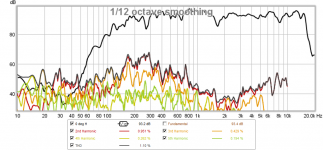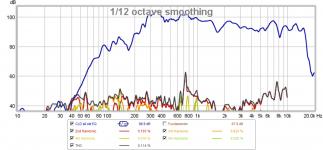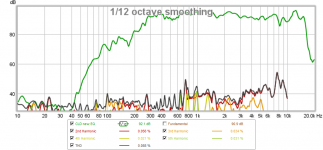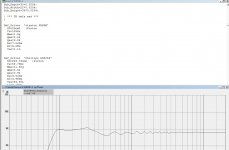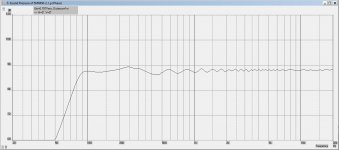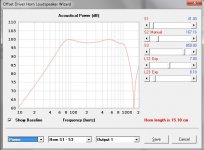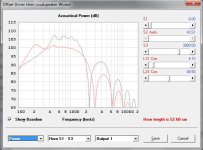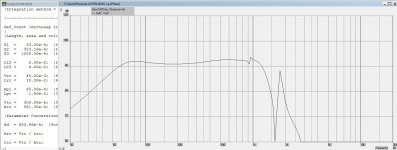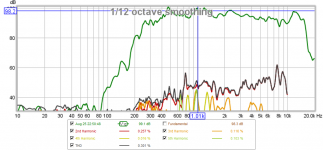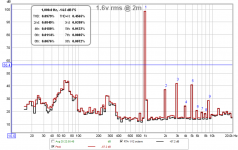I think things are looking optimisct that this should go to the next stage of being made of wood or fiberglass, etc. without too much risk that it will be a flop.
Fiberglass, although is often used in commercial products, is not the best material for horns IMO. Plywood has very predictable and very good sound charachter.
If those horns are couple of dollars/couple of days projects, you could humour yourself with also making a conical horn. I think they usually sound less colored/more natural than other flares I have heard, but the freq response might not be as even (HF drops more because of the contant directivity).
I would also try the horns with slightly decreasing HF content in room response (that is the key word). I usually prefer 1dB/octave decreasing response, give or take.
Constrained Layer Damping (CLD) Reduces HD
As I noted earlier that the foam panel vibrations were contributing to the harmonic distortion, my idea was to use a combination of CLD and bracing. Well I have the CLD implemented so far using two layers of foam core and latex caulking in between. I haven't gotten to the bracing yet but took some measurements to see if there was a difference. I actually had music playing through the horn during the CLD process and started noticing that it sounded different, in a good way. Vocals got clearer, and the volume got louder. I could feel that the walls vibrated significantly less. It is quite an improvement in the reduction of HD as you can see from the graphs below (before & after but same EQ).
Before CLD:
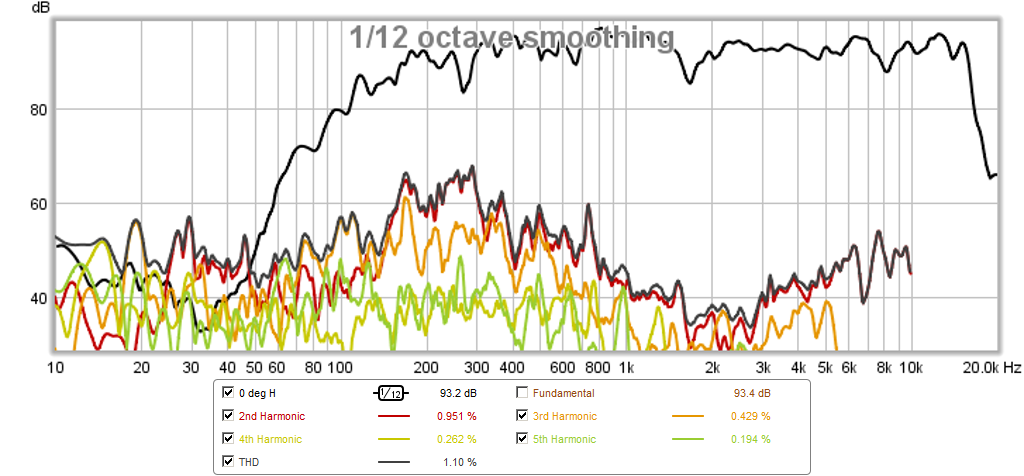
After CLD with same EQ as above - a HUGE improvement in HD, now with levels in the -50dB and as low as -60dB at certain frequency ranges:
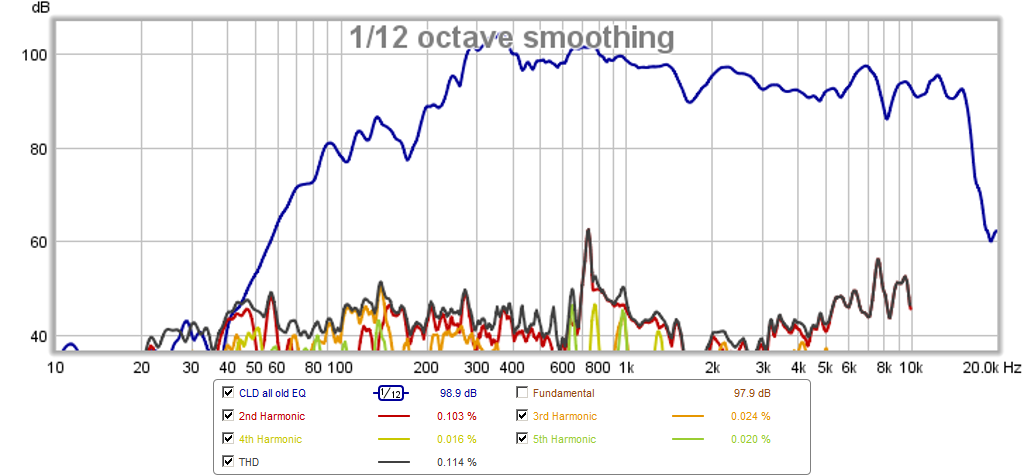
Here is the response and HD with the new EQ applied (I even used a positive peak EQ to flatten the 1.7 kHz dip caused by the horn throat cancellation and the distortion is still intact):
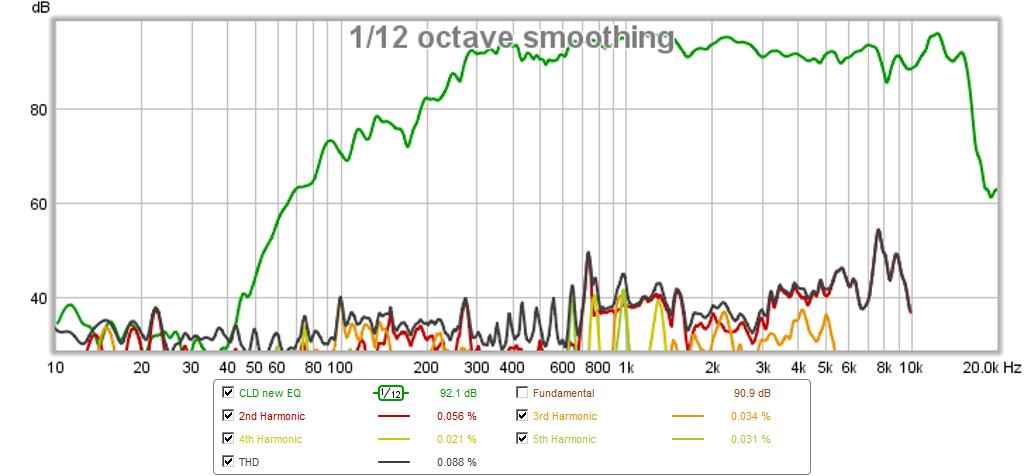
What do other horns look like HD wise? This is at a pretty decent level of 93dB average SPL.
Listening to it, I think it is clearer and very nice. Not sure if I still need bracing?
I will post sound clips later for you all to hear. So far though, I would have to say that this project is a success and will stay out of the trash bin.
As I noted earlier that the foam panel vibrations were contributing to the harmonic distortion, my idea was to use a combination of CLD and bracing. Well I have the CLD implemented so far using two layers of foam core and latex caulking in between. I haven't gotten to the bracing yet but took some measurements to see if there was a difference. I actually had music playing through the horn during the CLD process and started noticing that it sounded different, in a good way. Vocals got clearer, and the volume got louder. I could feel that the walls vibrated significantly less. It is quite an improvement in the reduction of HD as you can see from the graphs below (before & after but same EQ).
Before CLD:
After CLD with same EQ as above - a HUGE improvement in HD, now with levels in the -50dB and as low as -60dB at certain frequency ranges:
Here is the response and HD with the new EQ applied (I even used a positive peak EQ to flatten the 1.7 kHz dip caused by the horn throat cancellation and the distortion is still intact):

What do other horns look like HD wise? This is at a pretty decent level of 93dB average SPL.
Listening to it, I think it is clearer and very nice. Not sure if I still need bracing?
I will post sound clips later for you all to hear. So far though, I would have to say that this project is a success and will stay out of the trash bin.
Attachments
Last edited:
Kees,
Here is the Akabak script for the tractrix horn with synergy injection port for Kappalites. Remove the comment bar | in front of the OFF switches at each System to look at individual system.
Cheers,
X
This is a sample of the output from this code:
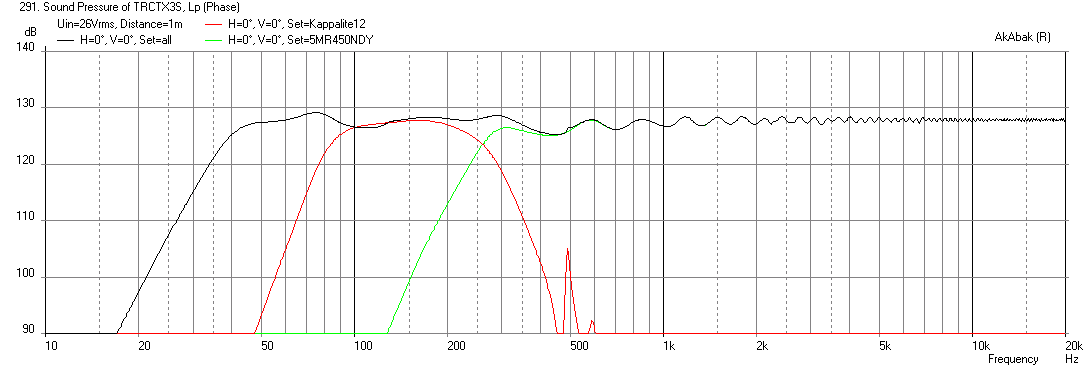
Thanks very much, I will try that!
PS nice kid!!
Last edited:
The kid is Timmy - famous spokes-baby for cable companies.
There is a lot reactions about that this horn can not perform well, because of the fall off above 5 khz, I do agree with them that a good single speaker horn has to be not need DSP processing, I do not use that at all, do not like that, I am more a analog man.
I do not now exactly what happens when use the horn like a senergy, this will give two horns in one, so high will work better that way?.
Also I do not understand that when akabak or hornresp predict nice graph that people say it can not be done, speaker technology is so old, and still we do not now everything, this say samething about the difficulty about it.
Sorry if my english is sometimes now so well.
regards
kees
Kees,
Look at the raw response data from this horn (black curve).
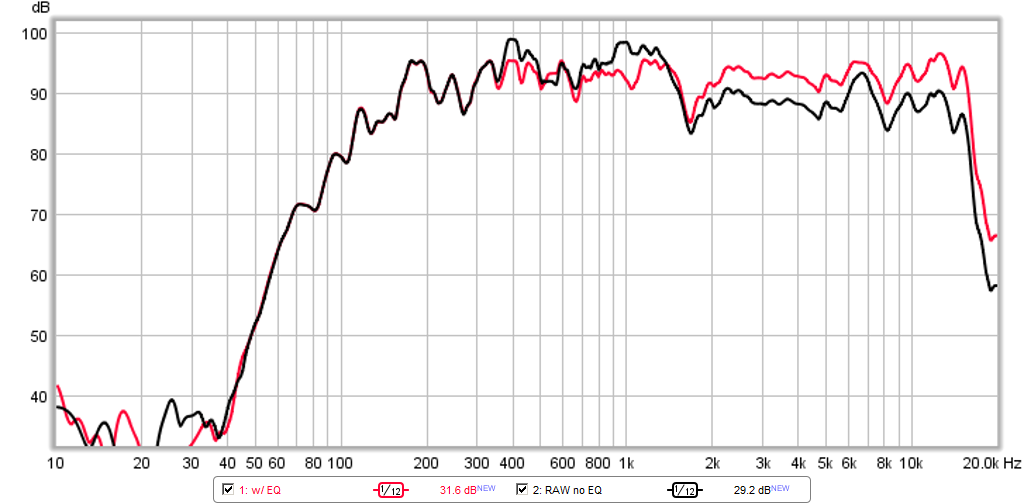
That is not a terrible response - I could have just applied a low shelf cut and ignore the sharp peaks and it would be close to what I have for the red curve. I have seen a lot of horn responses that have looked worse, and these are factory horns, DIY conical horns, exponential horns, etc. I haven't seen one that only requires less than 2dB tweaking on EQ. Like Anthony Bisset said, this horn opens up a opportunity for those not able or willing to integrate a CD, mid driver, and bass driver in either multiple horns or a Synergy with requisite time and spatial alignment. It's hard work to get a Synergy integrated properly. Here we have ability to do it with one driver plus a supporting sub. There are limitations and compromises certainly. It is not going to sound like a Danley 9-driver SH50. A wonderful speaker but super complicated and probably beyond the capability of many a DIYer to replicate (both cost and technical difficulty). I think the dip at 1.7kHz is the big issue and that can only be fixed with a phase plug. As I have said before I am trying to replicate something more along the lines of a Funktion1 Axehead single driver horn. A few things that should be noted is that this project is accessible to one without a wood work shop or powertools. The only tools I used are a razor, straightedge, and adhesive. No sawdust. I made it over three 2 hour sessions and the cost of the materials not including $105 driver is $15 ($8 in foam core, $4 in caulking, $2 hot glue sticks, $1 binding post).
Yes, AkAbak predicts HF above 5kHz, and measurements seem to show this. What was surprising was the wide polar coverage rather than a narrow beam as many have said would happen. How this is happening is probably diffraction/reflection effects in the horn so it may not be a true spherical wavefront? Not the end of the world as many speakers (Karlson) and even some horns (diffraction horns) use this to good effect.
If we accept as dogma what some pioneers have laid down as theory and principles not to be pushed, there would be no innovation and no progress. I wonder what many experienced horn builders pre-Danley said when he decided to use the concept of pressure injection through wall mounted ports! How crazy is that? I bet they all said that will never work etc because it will mess up the nice smooth wall and wavefront of the vertex mounted CD. What do you think all those people who said it will never work are saying now? They still make huge triple horns I guess.
Look at the raw response data from this horn (black curve).

That is not a terrible response - I could have just applied a low shelf cut and ignore the sharp peaks and it would be close to what I have for the red curve. I have seen a lot of horn responses that have looked worse, and these are factory horns, DIY conical horns, exponential horns, etc. I haven't seen one that only requires less than 2dB tweaking on EQ. Like Anthony Bisset said, this horn opens up a opportunity for those not able or willing to integrate a CD, mid driver, and bass driver in either multiple horns or a Synergy with requisite time and spatial alignment. It's hard work to get a Synergy integrated properly. Here we have ability to do it with one driver plus a supporting sub. There are limitations and compromises certainly. It is not going to sound like a Danley 9-driver SH50. A wonderful speaker but super complicated and probably beyond the capability of many a DIYer to replicate (both cost and technical difficulty). I think the dip at 1.7kHz is the big issue and that can only be fixed with a phase plug. As I have said before I am trying to replicate something more along the lines of a Funktion1 Axehead single driver horn. A few things that should be noted is that this project is accessible to one without a wood work shop or powertools. The only tools I used are a razor, straightedge, and adhesive. No sawdust. I made it over three 2 hour sessions and the cost of the materials not including $105 driver is $15 ($8 in foam core, $4 in caulking, $2 hot glue sticks, $1 binding post).
Yes, AkAbak predicts HF above 5kHz, and measurements seem to show this. What was surprising was the wide polar coverage rather than a narrow beam as many have said would happen. How this is happening is probably diffraction/reflection effects in the horn so it may not be a true spherical wavefront? Not the end of the world as many speakers (Karlson) and even some horns (diffraction horns) use this to good effect.
If we accept as dogma what some pioneers have laid down as theory and principles not to be pushed, there would be no innovation and no progress. I wonder what many experienced horn builders pre-Danley said when he decided to use the concept of pressure injection through wall mounted ports! How crazy is that? I bet they all said that will never work etc because it will mess up the nice smooth wall and wavefront of the vertex mounted CD. What do you think all those people who said it will never work are saying now? They still make huge triple horns I guess.
Last edited:
Hi
I have change your script, remove the tapped horn and filter and use only the bas mid.
Do you use only a high driver then I do not now if this is working well, but when a synergy it looks it does, I have some thought that it is not tractrix? you say that hornresp can not make much segments but dos calculates the flare I need there I can put the segemenst I need in cm, I have drawn the export see picture, some time ago.
The other photos are the visaton wideband speaker and the old 1976 phillips woofers, I put two on both sides I do not now you did also in script.
And yes I need to build it, I do not want a dB canon, it is for home use, I can also try to replace the frs8 for a tweeter biut most have not thiele small parameters and I do not now how to measure that with limp if it is possible, I think use a tweeter will be better, I go simulate a bas alone to see how far it extent.
I have download the volvotreter program but when use phillips it mass rollof in atractrix is 235 hz, (80 hrtz start), and it is nog so easy because I need autocad with it.
pictures are my drivers in your design, nothing changed but phillips have little more efficienty so on picture two I have change mid gain to 1.5.
regards kees
I have change your script, remove the tapped horn and filter and use only the bas mid.
Do you use only a high driver then I do not now if this is working well, but when a synergy it looks it does, I have some thought that it is not tractrix? you say that hornresp can not make much segments but dos calculates the flare I need there I can put the segemenst I need in cm, I have drawn the export see picture, some time ago.
The other photos are the visaton wideband speaker and the old 1976 phillips woofers, I put two on both sides I do not now you did also in script.
And yes I need to build it, I do not want a dB canon, it is for home use, I can also try to replace the frs8 for a tweeter biut most have not thiele small parameters and I do not now how to measure that with limp if it is possible, I think use a tweeter will be better, I go simulate a bas alone to see how far it extent.
I have download the volvotreter program but when use phillips it mass rollof in atractrix is 235 hz, (80 hrtz start), and it is nog so easy because I need autocad with it.
pictures are my drivers in your design, nothing changed but phillips have little more efficienty so on picture two I have change mid gain to 1.5.
regards kees
Attachments
Last edited:
Kees,
That looks pretty good, did you also specify the driver name change in addition to putting its parameters into the definition? It's just surprising how well it works for a completely different driver. Post your script if you want feedback.
That looks pretty good, did you also specify the driver name change in addition to putting its parameters into the definition? It's just surprising how well it works for a completely different driver. Post your script if you want feedback.
Kees,
That looks pretty good, did you also specify the driver name change in addition to putting its parameters into the definition? It's just surprising how well it works for a completely different driver. Post your script if you want feedback.
Hi
Yes i did change the definitions and the thiele small parameters and remove the tapped horn and filter for it, and afourse the names.
I have read some hornstuff on the internet, all talk about tweeter fall off to soon in a horn, I did also read a tractrix has extensive frequenty respons, that is the reason it is a tractrix, coming from the time that a pick up has no amp but only a horn.
much stuf who is make things complicated.
Because of your horn is a synergy it has such respons because it can be seen as two horns?.
What concerns the alpass filters do you use bessels? because these are the best for that task making a wideband alpass possible.
Be the way I have very strange pc problems, like empty screens when look foto,s akabak do not copy to clipboard so I can not inplement filters, pc sometimes do things without me etc. I think the big transmitter from my nabure do radiate into the usb, it radiates also in my amplifier and because of valves it is not easely removed, he has a 6.5 watts wifi on his roof getting 15 km away on 5.8 gigahertz, very close to my bed also, and this is all alowed in the nederlands.
Oke, I have put info on the foto, you see also some hornresp sims where the phillips go very wide, but the horn is very wide and short to get this (14cm), some thoughts?.
how big do you make the throat? 1x Sd, 0.5 x Sd ?
regards
kees.
Attachments
Last edited:
how big do you make the throat? 1x Sd, 0.5 x Sd ?
I made the Sd dia equal to diagonal of square throat. So Throat is 64% of Sd.
NEO Dan,
Unfortunately, that 1.7 kHz dip is not a back reflection but results from a 4.1 in path cancellation corresponding to the diagonal distance from one vertex to the opposite vertex in the horn throat. Only way to fix this is to use a phase plug or maybe make a round throat that transitions to square. So, no hats off to me I guess... 😀 In any event, the raw vs EQ'd response looks not so bad, with that cancellation dip being the only major blemish.
Hats off regardless, seriously.
Now you get to tinker in the front chamber and throat, you could divide it up into sections like an orange extending into the throat a bit...
Hats off regardless, seriously.
Now you get to tinker in the front chamber and throat, you could divide it up into sections like an orange extending into the throat a bit...
Hey thanks. You mean like this?
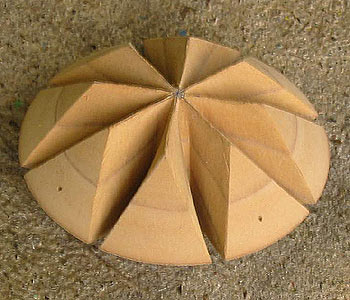
Great link by Legis earlier: [URL="http://www.centauriaudio.com.au/diy/plugs.html"]http://www.centauriaudio.com.au/diy/plugs.html[/URL]
Hi Again
when I try to use the volvotreter tractrix sheet I get not really good results, I need to shorten te horn and make the mouth smaller to get it like in the photo, the phillips do go wide, make it possible to use a nice tweeter as horn driver.
if afcourse things are working that way, like the hornresp export to akabak, I have include a low pass filter in it also put on 1 khz.
when use the conic version of the horn, the woofer go wider as with a exp or tractrix flare see picture two..
regards
kees
when I try to use the volvotreter tractrix sheet I get not really good results, I need to shorten te horn and make the mouth smaller to get it like in the photo, the phillips do go wide, make it possible to use a nice tweeter as horn driver.
if afcourse things are working that way, like the hornresp export to akabak, I have include a low pass filter in it also put on 1 khz.
when use the conic version of the horn, the woofer go wider as with a exp or tractrix flare see picture two..
regards
kees
Attachments
Last edited:
Hey thanks. You mean like this?

Great link by Legis earlier: [URL="http://www.centauriaudio.com.au/diy/plugs.html"]http://www.centauriaudio.com.au/diy/plugs.html[/URL]
This is now exactly why we use a compression driver for it, to avoid that trapped space between cone and mouth.
but nice link, shure worth it to try.
regards
You probably do not need nearly the displacement of volume, I was thinking more along the lines of some simple dividers in a similar arrangement.Hey thanks. You mean like this?
....
Listening to it, I think it is clearer and very nice. Not sure if I still need bracing?
...
Touch it when playing. If you can feel vibration, then it'd be worth doing it. Of course the real difference will be small, but it's audible when comparing a very well-damped horn and a vibrating one.
Subjectively, it'd feel calmer, quieter, less noise, more composed,... etc. I'm not sure if it's measurable. Also, I'm not sure if it's worth the effort. YMMV.
Anyway, your measurements are already very good. Well done!
New Polar Data with CLD Tractrix
I wanted to see if the constrained layer damping (CLD) affects the polar response - it does. I also ran the horn at a higher drive voltage to see how that affects distortion.
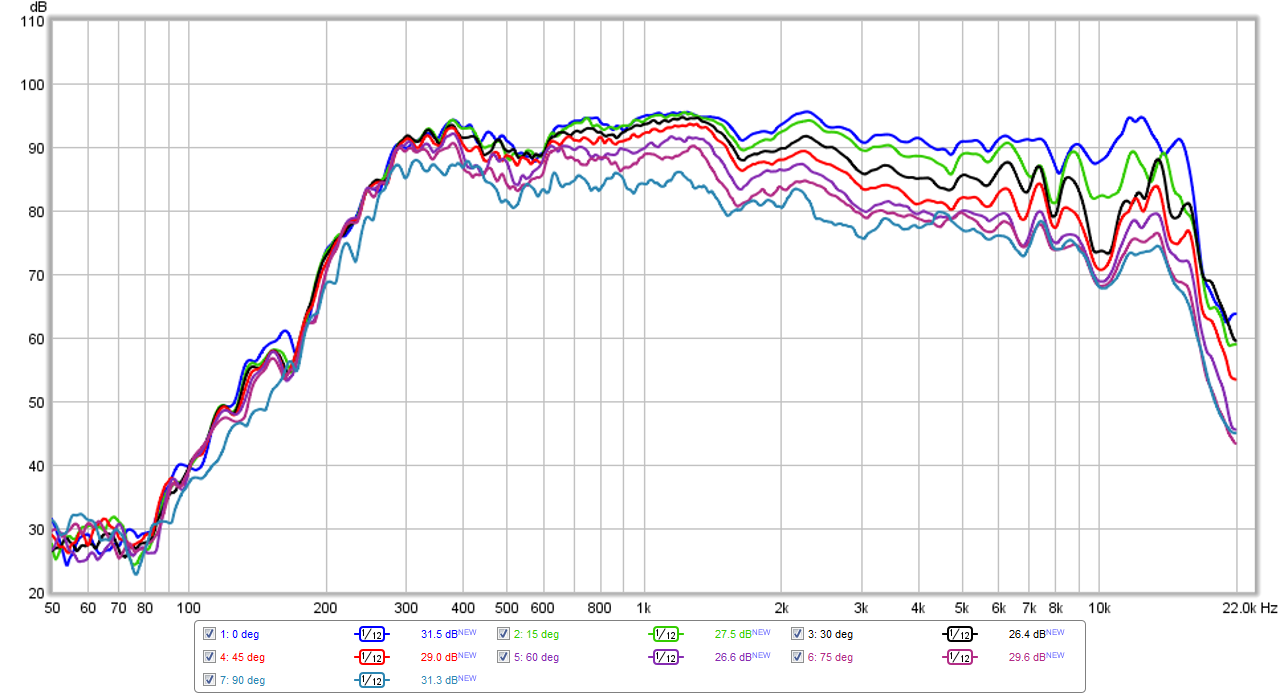
In order not to clip the mic, I had to move the mic back to 2m and got about 98dB, or 104dB at 1m. The HD still looks pretty good:
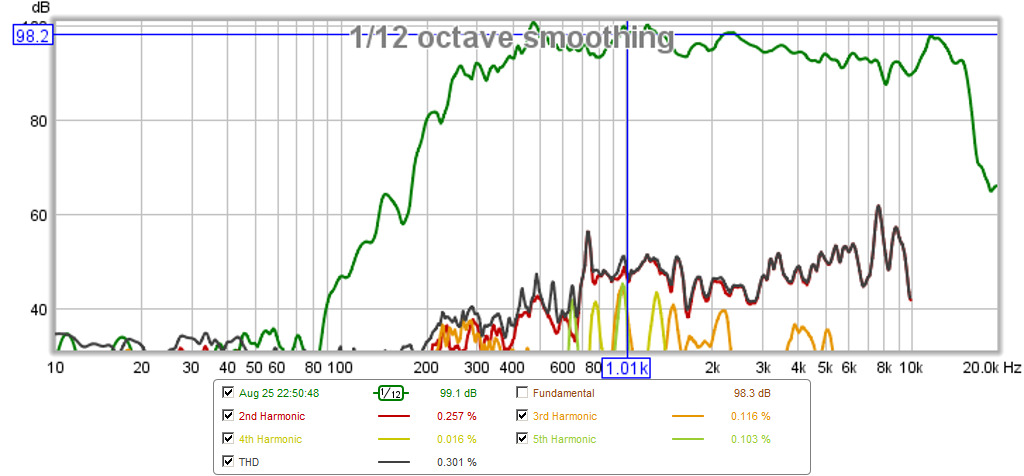
And here is the RTA with a 1kHz sine wave has the THD at less than 0.1%:
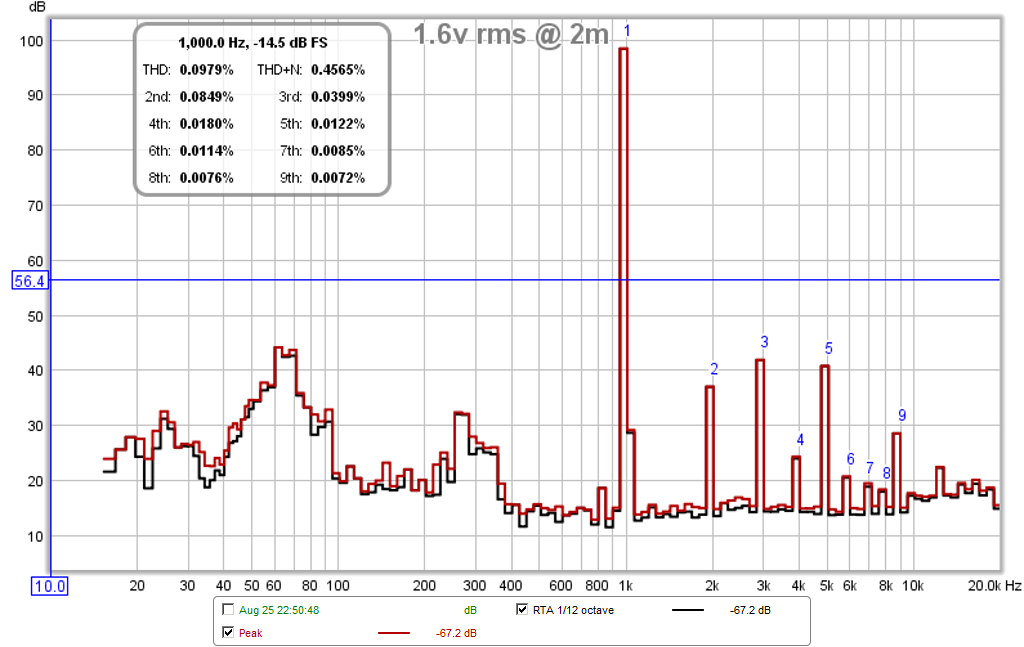
Also, here is a sound clip with the new CLDs setup.
I wanted to see if the constrained layer damping (CLD) affects the polar response - it does. I also ran the horn at a higher drive voltage to see how that affects distortion.
In order not to clip the mic, I had to move the mic back to 2m and got about 98dB, or 104dB at 1m. The HD still looks pretty good:

And here is the RTA with a 1kHz sine wave has the THD at less than 0.1%:

Also, here is a sound clip with the new CLDs setup.
Attachments
Last edited:
You have low noise measuring equoment, mine have massive phantom voltage/mic driver noise that rises towards the LF. What mic/mic amp/sound card do you use?
I would be interested to see how horn's damping affected the raw response, compared to the old raw.
I would be interested to see how horn's damping affected the raw response, compared to the old raw.
Legis,
Funny how you call it low noise🙂. Nothing special, just a $80 calibrated mic from PE. I think miniDSP has a similar UMIK-1 that may work well too. I use a Dayton UMM-6 USB mic - I really like how simple it is to use. Because it is a USB mic it has the preamp and ADC circuit right at the mic capsule to minimize noise. You also never worry about the sound card calibration for the ADC so it also has calibrated SPL and I don't need to use an SPL meter. One thing to be careful of is how USB gets started properly when it is inserted and REW interacts with it. Go into settings to make sure that the mic level is fixed at 1.0 manual gain. Then check SPL level of ambient noise (45 dB in my house). If the mic level is not set correctly (REW auto levels) you get 70dB - go into settings to change. Also it clips at 110dB so no high SPL levels near cone can be done. Sine wave testing at 100dB was at limit of my hearing tolerance I should have gotten ear plugs. I turned my system up as loud as I could tolerate with music and peaks hit 105dB and it still sounds clean. Let me find the raw response with the CLD - it looks very different than no damping. Less HF SPL - maybe walls were re-radiating? Maybe not so bad if one did not care about LF HD if using with HPF at higher frequencies.
Funny how you call it low noise🙂. Nothing special, just a $80 calibrated mic from PE. I think miniDSP has a similar UMIK-1 that may work well too. I use a Dayton UMM-6 USB mic - I really like how simple it is to use. Because it is a USB mic it has the preamp and ADC circuit right at the mic capsule to minimize noise. You also never worry about the sound card calibration for the ADC so it also has calibrated SPL and I don't need to use an SPL meter. One thing to be careful of is how USB gets started properly when it is inserted and REW interacts with it. Go into settings to make sure that the mic level is fixed at 1.0 manual gain. Then check SPL level of ambient noise (45 dB in my house). If the mic level is not set correctly (REW auto levels) you get 70dB - go into settings to change. Also it clips at 110dB so no high SPL levels near cone can be done. Sine wave testing at 100dB was at limit of my hearing tolerance I should have gotten ear plugs. I turned my system up as loud as I could tolerate with music and peaks hit 105dB and it still sounds clean. Let me find the raw response with the CLD - it looks very different than no damping. Less HF SPL - maybe walls were re-radiating? Maybe not so bad if one did not care about LF HD if using with HPF at higher frequencies.
Last edited:
Legis,
Funny how you call it low noise🙂. Nothing special, just a $80 calibrated mic from PE.
Everything is relative, low noise compared to mine 😀. Take a look: http://www.diyaudio.com/forums/subwoofers/258706-study-dipole-cardioid-bass-horn-30.html#post4037492
- Home
- Loudspeakers
- Full Range
- PRV 5MR450-NDY for FAST/WAW applications
